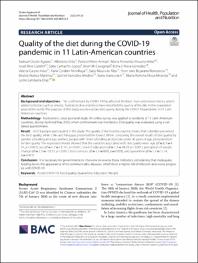Quality of the diet during the COVID‑19 pandemic in 11 Latin‑American countries

Ver/
Descargar
(application/pdf: 1.028Mb)
(application/pdf: 1.028Mb)
Fecha
2022-08-04Autor(es)
Durán‑Agüero, Samuel
Ortiz, Alfonsina
Pérez‑Armijo, Patricio
Vinueza‑Veloz, María Fernanda
Ríos‑Castillo, Israel
Camacho‑Lopez, Saby
Cavagnari, Brian M.
Nava‑González, Edna J.
Carpio‑Arias, Valeria
Cordón‑Arrivillaga, Karla
Mauricio‑Alza, Saby
Bejarano Roncancio, Jhon Jairo
Nuñez‑Martínez, Beatríz
González‑Medina, Gabriel
Ivancovich, Sonia
Meza‑Miranda, Eliana Romina
Landaeta‑Díaz, Leslie
Metadatos
Mostrar el registro completo del ítemResumen
“Background and objectives: The confnement by COVID-19 has afected the food chain and environments, which
added to factors such as anxiety, frustration, fear and stress have modifed the quality of the diet in the population
around the world. The purpose of this study was to explore diet quality during the COVID-19 pandemic in 11 Latin
American countries.
Methodology: Multicentric, cross-sectional study. An online survey was applied to residents of 11 Latin-American
countries, during April and May 2020, when confnement was mandatory. Diet quality was evaluated using a vali‑
dated questionnaire.
Result: 10,573 people participated in the study. The quality of the food by country shows that Colombia presented
the best quality, while Chile and Paraguay presented the lowest. When comparing the overall results of diet quality by
gender, schooling and age, women, people with more schooling and people under 30 years of age, presented bet‑
ter diet quality. The regression model showed that the variables associated with diet quality were: age (df=3, F=4.
57, p<0.001), sex (df=1, F=131.01, p<0.001), level of education (df=1, F=38.29, p<0.001), perception of weight
change (df=2, F=135.31, p<0.001), basis services (df=1, F=8.63, p=0.003), and quarantine (df=1, F=12.14,
p=0.001).
Conclusion: It is necessary for governments to intervene to reverse these indicators, considering that inadequate
feeding favors the appearance of no communicable diseases, which favor a higher risk of infection and worse progno‑
sis with COVID-19.“
Palabras clave
Colecciones
- SCOPUS [380]

